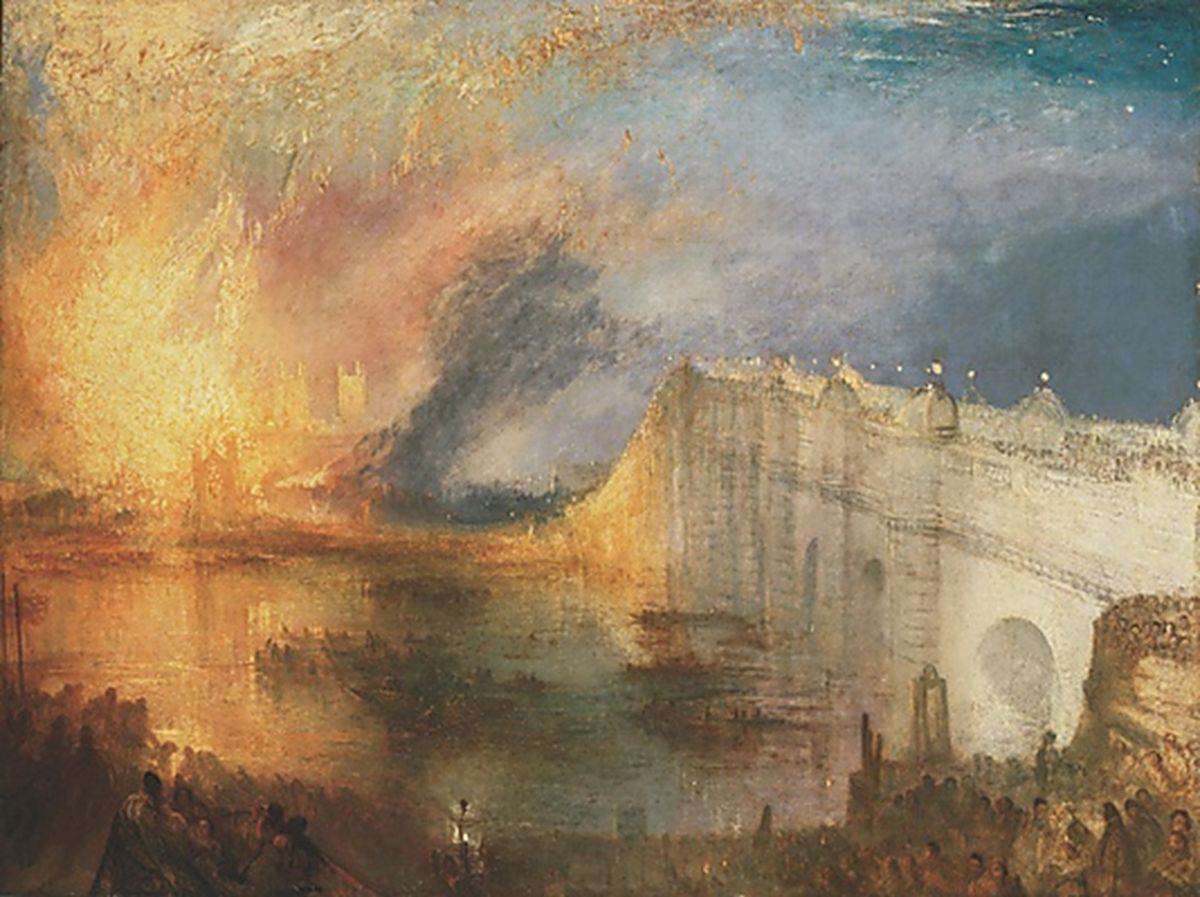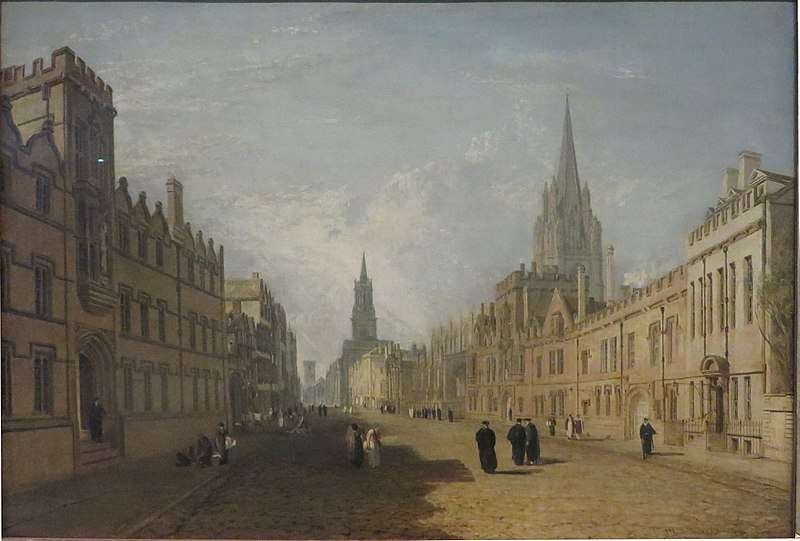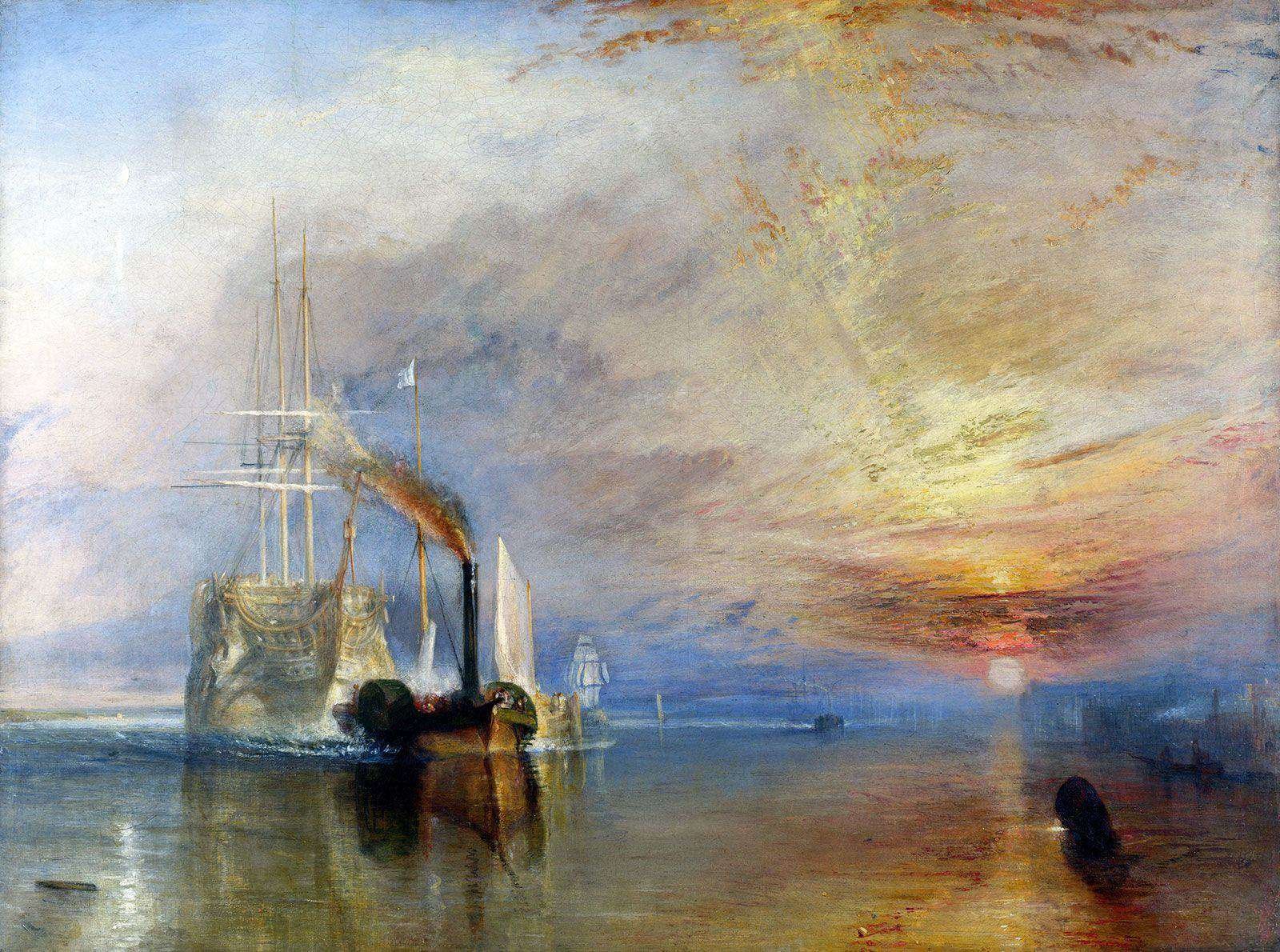William Turner is an iconic artistic genius and I have always loved his artwork and impressionistic style. He has been one of my favorites since I was in my youth, the vibrant colors he used in his paintings always inspired me. I have always wanted to be a painter and his masterpieces motivated me to become an artist.
Joseph Mallord William Turner (1775-1851) painter, printmaker, and watercolorist, is one of the best loved British artists. His style was early Romanticism which had a major impact on later Impressionist and modern abstract art. He became known as the “painter of light”. He was recognized as an artistic genius and his fame came from his interesting, brilliant colors and innovative style. Intensely private, eccentric, and reclusive, Turner was a controversial figure throughout his career.
His most popular works of art were colorful landscapes and seascapes. Turner liked to paint shipwrecks, fires, and natural phenomena such as sunlight, storms, rain, and fog. He was fascinated with the power of the sea and the weather.
Watercolors were the most used medium he liked to work with. Turner was considered the first modern artist and influenced the French Impressionists. He left a prolific amount of artwork – 550 oil paintings, 2,000 watercolors, and 30,000 works on paper.

“Keelmen Heaving In Coal by Moonlight” 1835, National Gallery, Washington DC.
Turner’s Quotes On His Art
“Indistinctness is my forte.”
“It is only when we are no longer fearful that we begin to create.”
“To select, combine and concentrate that which is beautiful in nature and admirable in art is as much the business of the landscape painter in his line as in the other departments of art.”
“I have no secret but hard work. This is a secret that many never learn, and they don’t succeed because they don’t learn it. Labor is the genius that changes the world from ugliness to beauty, and the great curse to a great blessing.”
“It is necessary to mark the greater from the lesser truth: namely the larger and more liberal idea of nature from the comparatively narrow and confined; namely that which addresses itself to the imagination from that which is solely addressed to the eye.
“I don’t paint so that people will understand me, I paint to show what a particular scene looks like.”
“My job is to paint what I see, not what I know.”
“Painting is a strange business.”
“Painting can never show her nose in company with architecture but to have it snubbed.”
“There’s a sketch at every turn.”
“I know of no genius but the genius of hard work.”
“If I could find anything blacker than black, I’d use it.”

“The Burning of the House of Lords” by Turner, 1834, Philadelphia Museum of Art

“Dort Boat From Rotterdam Becalmed,” 1818, Yale Center For British Art.
Art Critics on Turner’s Art
The British writer Peter Cunningham, in his obituary of Turner, wrote that it was: “recognised by the wiser few as a noble attempt at lifting landscape art out of the tame insipidities and evinced for the first time that mastery of effect for which he is now justly celebrated.”
Biographer Andrew Wilton said that his images are “a summary of all that had been said about the sea by the artists of the 18th century.”
According to David Piper’s The Illustrated History of Art, his later pictures were called “fantastic puzzles”.
Turner was recognized as an artistic genius; the English art critic John Ruskin described him as the artist who could most “stirringly and truthfully measure the moods of Nature”.
John Ruskin said that an early patron, Thomas Monro, Principal Physician of Bedlam, and a collector and amateur artist, was a significant influence on Turner’s style: “His true master was Dr. Monro; to the practical teaching of that first patron and the wise simplicity of method of watercolour study, in which he was disciplined by him and companioned by his friend Girtin, the healthy and constant development of the greater power is primarily to be attributed; the greatness of the power itself, it is impossible to over-estimate.”
According to The Art Story website “Turner took classical genres and scenes – the stately landscape in well-designed compositions and historical events writ large – and infused them with a new dynamic in painting. He reflected on the increasing importance of individual experience in the era of the Enlightenment, where the perceptions of human beings led to exalted personal moments and sublime interactions with nature. Through this dedication to rendering heightened states of consciousness and being, he helped define the cross-disciplinary artistic movement of Romanticism, setting the stage for later developments in painting subjective experiences that would lead to Impressionism. In some of his later works especially, Turner responded to the arrival of the modern era by making the contraptions of human invention powerfully, sometimes threateningly present.”
“Few artists have had a lasting influence on the history of art like J.M.W. Turner. Living and working in 19th-century London, the English painter is known for his interest in powerful subject matter, as evident in both his sublime landscapes and studies of modern machinery. While Turner is seen as a pioneer of Romanticism, he is most celebrated for facilitating the emergence of modern art.” Kelly Richmand-Abdou, My Modern Met.
“His contemporaries recognized his graft and determination, and also his creative bravery,” biographer Franny Moyle told Artsy. “He was often prepared to make experiments that they were not. He led the way.”
In the words of Joseph Farington, a longtime leader at the Royal Academy, “Turner has no settled process but drives the colours about till he has expressed the ideas in his mind.”
According to the Tate Museum,” J.M.W. Turner may have regarded himself first and foremost as a landscape painter, but his art tells us a lot about the volatile and rapidly modernising times that he lived through. His lifelong interest in the inventions, conflicts, politics, society, culture and science of his time influenced many of his most original works and transformed his way of painting.”

“Stormy Sea with Blazing Wreck” 1835, Tate Britain, London
Turner’s Life

Turner self portrait
Turner was a child prodigy and from a young age Turner had an interest in drawing and painting. His father even sold some of his first drawings. He sold some paintings at age 13, after moving in with his uncle. Turner attended the drawing classes from the master painter Thomas Malton, an English artist who had his own style of architectural views. Turner thought of his first teacher as the true master.
At age 15 he had painted a watercolor composition that was highly acknowledged by the Royal Academy of Arts. Turner entered the Royal Academy schools in 1789 and soon began exhibiting his watercolors there. From 1792 on he spent his summers touring the country in search of subjects, filling his sketchbook with drawings to be worked on later into finished paintings. His early work was traditional in technique and his inspiration was the great masters of the day.

“View of High Street, Oxford” 1810, Ashmolean Museum, Oxford.
In 1794 Turner began working for engravers, supplying designs for the Copper Plate Magazine and the Pocket Magazine. He was also employed to make copies and elaborations of unfinished drawings by the landscape painter John Robert Cozens. The influence of Cozens and the Welsh landscape painter Richard Wilson helped inspire Turner’s painting style. It revealed to him the poetic and soft touch he incorporated in his paintings. He had a whole new approach to landscape paintings after working with these great artists.

“The Fighting Temeraire” 1838, National Gallery, London
From 1796 Turner exhibited oil paintings as well as watercolors at the Royal Academy. The first, “Fisherman at Sea” 1796, is a moonlight scene and was acclaimed by a contemporary critic. At the age of 24 Turner was elected as an associate of the Royal Academy and in 1802 he became a full academician.
It was a great honor to him and he marked the occasion with a series of large paintings in which he emulated the achievements of the old masters. Especially the 17th century painters like Nicolas Poussin, Claude Lorrain, Albert Cuyp, and William Van de Velde that inspired his art style. In 1807 he was appointed professor of perspective, a great achievement for a young talented and aspiring artist.

“Modern Rome, Campo Vaccino” 1839, J. Paul Getty Museum, Los Angeles.
Turners’ private life was secretive and somewhat eccentric. In 1798 he entered into an affair which was to last about 10 years with Sarah Danby. They ended up having two children. In 1800 his mother fell ill and was sent to live in a hospital. His father went to live with him and helped him run his art studio. His studio was at 64 Harley Street in London and in 1804 he opened a private gallery.
At his private gallery he continued to show his latest work. He was by this time rewarded with many commissions. The success of his career was assured. Turner continued to travel in search of inspiration. He visited Wales, Yorkshire, the Lake District, and the Midlands. In 1801 he traveled to Scotland and the European continent in 1802.
The crossing to Calais was rough and in his picture Calais Pier 1802 left a vivid record of his experience upon arrival. He made more than 400 drawings during this tour of France and Switzerland. He continued for many years to paint pictures of scenes that had impressed him on the trip. He also took a trip to the Louvre to study the old masters.

“Calais Pier” 1801, National Gallery, London
Developing His Unique Style

”Sunset” 1835, The Tate, London
Turner’s many sea scape drawings and artwork, were inspired by the Dutch 17th Century tradition and style. After studying this type of style. Others started looking at his paintings like he looked at great works of art. His fame as the romantic impressionist was now admired by the world.
His oil paintings in 1805 –1807 suggest that at this time, Turner was developing an original approach to landscape paintings. He began to emphasize luminosity and atmosphere, with a soft romantic touch that brought him his fame to the world.
In 1807 Turner began his great enterprise of publishing a series of 100 plates known as the Liber Studiorum. Turner’s aim was to document the great variety and range of landscapes. Some were taken from his own existing paintings and watercolors.
Turner was much in demand as a painter of castles and country seats for their owners, while he continued to excel on marine paintings. Turner used natural forces to lend drama to historical moments he experienced on his travels.
The coming peace in Europe in 1815 allowed Turner to travel to seek inspiration once again. He visited Waterloo and the Rhine in 1817, he explored Italy in 1819, visiting ancient cities and historical ruins of the past.
He spent three months in Naples, Florence, and Venice studying ancient architecture from the Renaissance. During his journey he made about 1,500 drawings, and in the next year he painted a series of paintings inspired by the drawings from this adventure.

“Venice, the Dogena and San Giorgio Maggiore” 1834, National Gallery, Washington DC
His artwork during this period shows a great advance to his style, the colors in his paintings were seen as purer and more vibrant with soft highlights, attracting the eyes to the details of light and shadow. Whereas in his earlier work his style of painting was soft and almost transparent. With soft pastels which gave him fame for being a romantic impressionist.
In these new paintings the shadows are as colorful as the lights and he achieves contrast by using warm colors for his shadows rather than dark colors. A whole new style developed during this period in his later life.

“Brighton From the Sea” 1829, The Tate, London
During the 1820’s Turner alternated tours of the continent. He visited various parts of England and Scotland. In 1827 –1829 he went to explore Italy again. In 1829 his father passed away. He found himself staying with the Earl of Egremont at Petworth, Sussex. He produced splendid sketches of the Earl’s house and gardens.
In the later years of his life, he grew in popularity and fame. Enquiring a good amount of wealth, by the end of his life. By the year 1838 he resigned at The Royal Academy ending a long career as a professor of perspective.
At the end years of his life, he moved into a house by the river at Chelsea, where he lived with Sophia Caroline Booth. Together they traveled for the last 15 years of his life. He visited Italy, Switzerland, Germany and France, he sketched 19,000 drawings of his adventures in the last days, he was a great inspiration to many worldwide.
Turner’s Legacy

Photograph of Turner
Turner was the greatest landscape artist of the 19th century. He was considered a pioneer in the study of light, color, and atmosphere. He believed that his work should show images of historical, mythical, and literary landscapes and the sea. These later works express the relationship between man and his environment. The power of nature or the terror felt in a violent storm. Simple feeling of peace as the sun breaks through the clouds, at morning’s first light.
Turner’s growing reputation in the second half of the 19th century was largely due to the influential British art critic John Ruskin, who published the first part of Modern Painters in 1843. He gave Turner a wonderful review that added to his growing popularity and worldwide fame.
British filmmaker Mike Leigh wrote and directed Mr. Turner, a biopic film of Turner’s later years, released in 2014. The film stars Timothy Spall as Turner, Dorothy Atkinson, Marion Bailey and Paul Jesson, and premiered in competition for the Palme d’Or at the 2014 Cannes Film Festival, with Spall taking the award for Best Actor.
In conclusion, Turner is considered one of the greatest romantic artist of the 19th century. A great appreciation for the abstract qualities of his later works became quite popular in modern times. His color compositions strengthened his popularity, he became known as the most innovative and talented artist of his century.

“Rain, Steam and Speed –The Great Western Railroad” 1844, National Gallery, London

“Going to the Ball, San Martino” 1846, Tate Britain, London

“Venice Noon” 1845, Tate Britain, London

“Norham Castle” 1845, Tate Britain, London

“Snow Storm, Steam Boat off a Harbour’s Mouth” 1842, Tate Britain, London
References
- Standing in the Sun: A Life of J. M. W. Turner, Anthony Baily, Pimlico, London, 1998.
- The Life of J. M. W. Turner, A.J. Finberg, Oxford University Press, 1961.
- Turner, James Hamilton, Random House, NY, 2007.
- Turner: The Extraordinary Life and Momentous Times of J.M.W. Turner, Franny Moyle, Penguin/Random House, NY, 2016.



